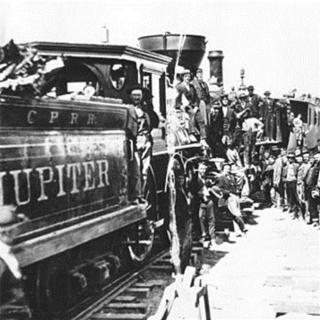
介绍:
They carried out a Pharaonic feat of labor, uniting the states. Few in history have done so much but been credited so sparsely.
For decades the contributions of Chinese railroad workers to the most important construction project in mid-19th century America, the transcontinental railroad, were largely ignored.
On May 10, 1869, Chinese employed by the Central Pacific Railroad hammered in the final rails before the famous golden spike was driven in at Promontory Point, Utah.
Physically and symbolically the completed rail linked what had, just a few short years earlier, been a nation ripped asunder by civil war. The Chinese workers were officially recognized in May 2014 at a ceremony in Washington.
More than 12,000 workers from southern China were hired by the Central Pacific Railroad. They made up the overwhelming majority of its workforce, far outnumbering other nationalities.
The iconic photo, with two facing, almost menacingly impatient, locomotives surrounded by white workmen, depicts the moment when the line was completed. The company did actually honor the Chinese workers at Promontory Point. As the photo was being organized, they invited representatives to meet company executives in a special rail car.
However, at that precise moment, either by design or fault, Andrew J. Russell shouted “smile and look at the camera’’ to those who had been meticulously assembled by the locomotives. It was one of the images that defined America but it was not a definitive depiction of what had gone before.
Would history have been different if the Chinese workers had been in the photo and publically credited for their immense input? Possibly.
The Chinese Exclusion Act of 1882 banned Chinese laborers from entering the US. Chinese immigrants already in America were barred from obtaining citizenship. The act was repealed in December, 1943.
The Pacific Rail Bill that congress passed in 1862 committed the nation to the completion of a line that would span the continent to help the country get closer to Asia and, ironically, in view of the photo, China in particular. The outbreak of the civil war made it imperative to deliver a sense of unity. Congress selected the Central Pacific to build east from Sacramento and the Union Pacific to build west from the Missouri River.
The Union Pacific had the less arduous task with relatively flat terrain to cross and hiring labor was no problem. The Central Pacific section had few workers and the Sierras to overcome.
Thousands of Chinese toiled in scores of labor gangs. Facing two of the worst winters on record, the Chinese tunneled through solid granite cliffs, felled trees and laid the track that knitted the country together. The line was like a bandage over a war wound, a sign of healing.
They used primitive equipment, pick and shovel, and explosives to hack out Summit Tunnel. Disease, explosions, land and snow slides took a cruel toll.
Relations between the US and China can sometimes seem fraught. But an understanding of those who helped forge the United States can provide an insightful counterbalance and a narrative of inspiration.
上一期: China sending football market to stratosphere 价格不菲的中国足球
下一期: Forgiving a thief in the night---原谅
下一期: Forgiving a thief in the night---原谅
大家还在听

